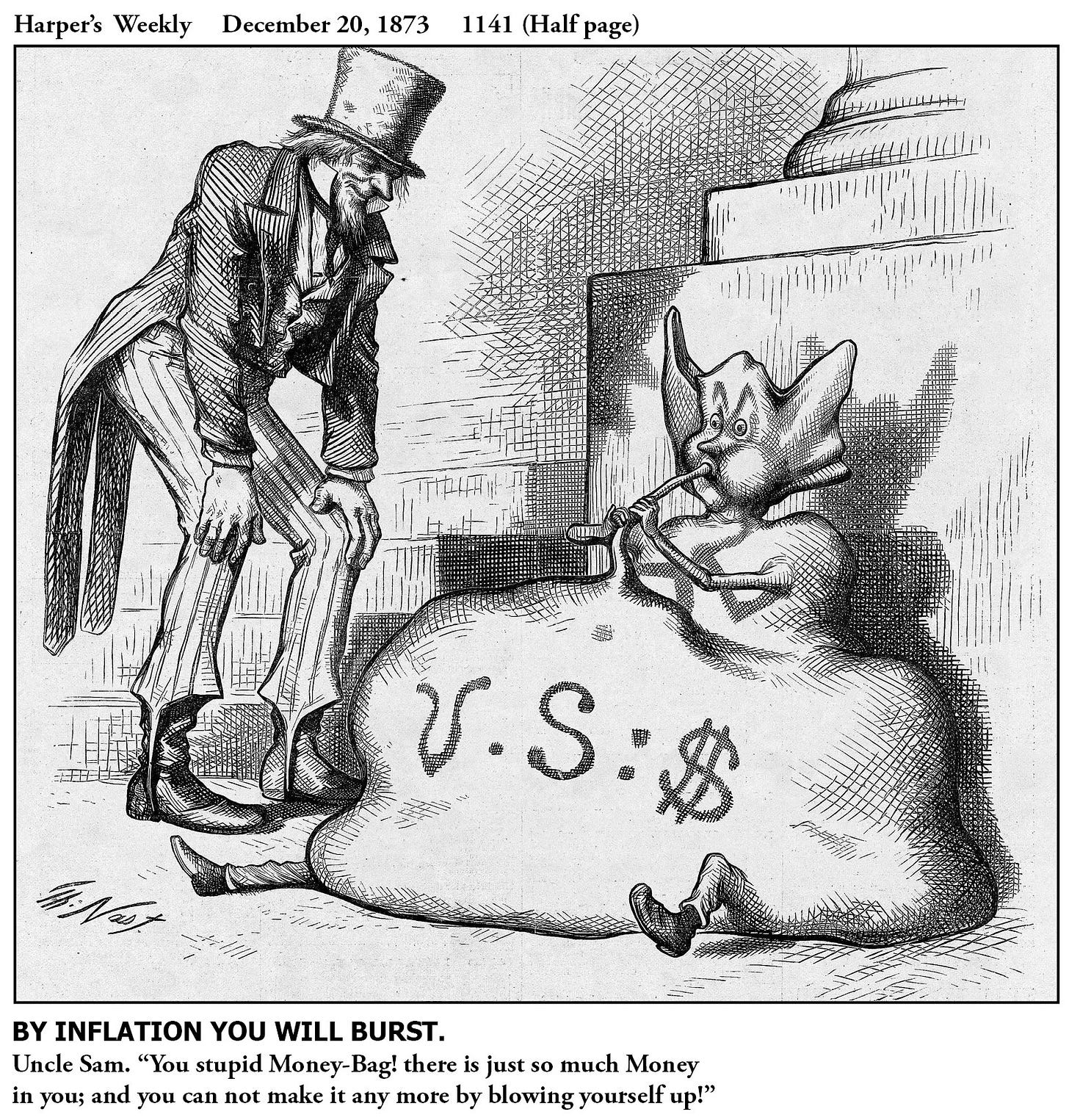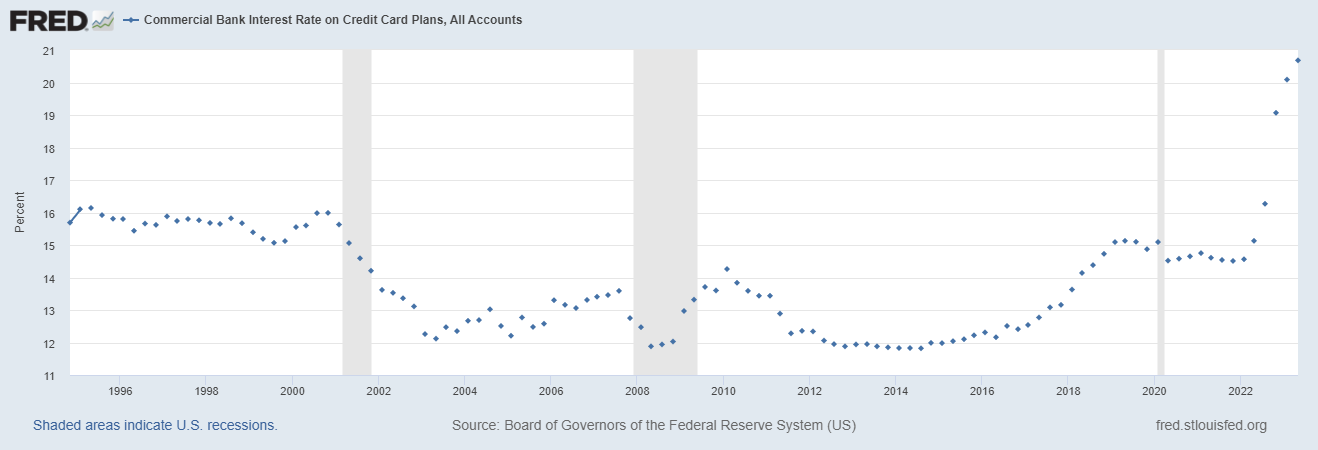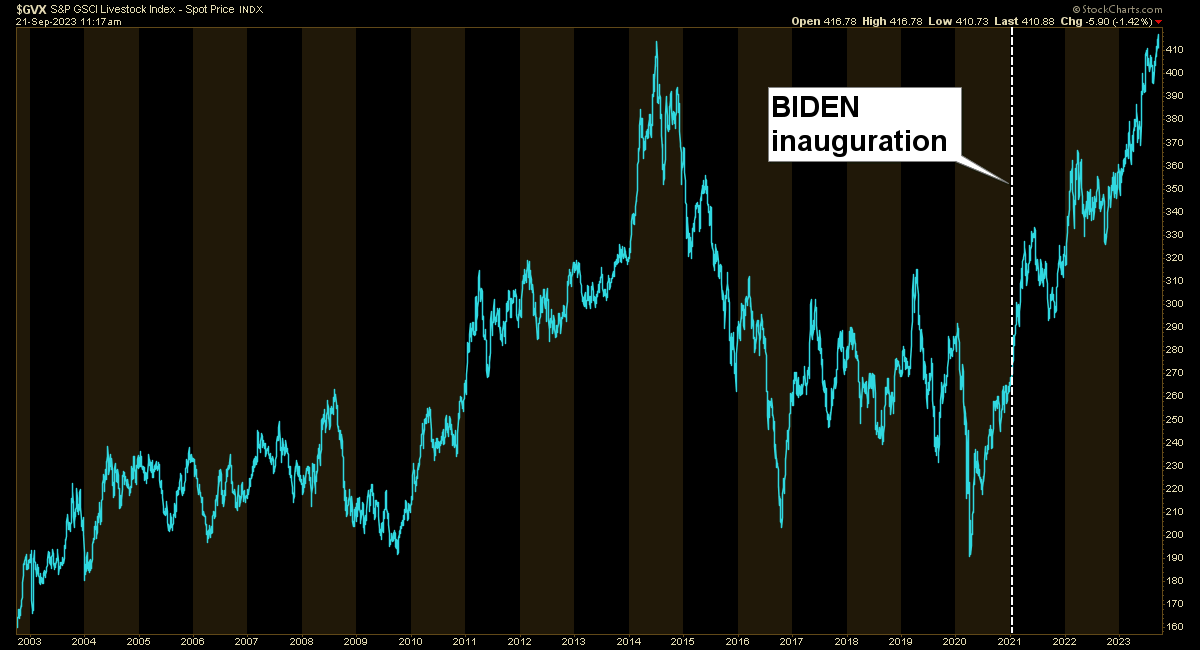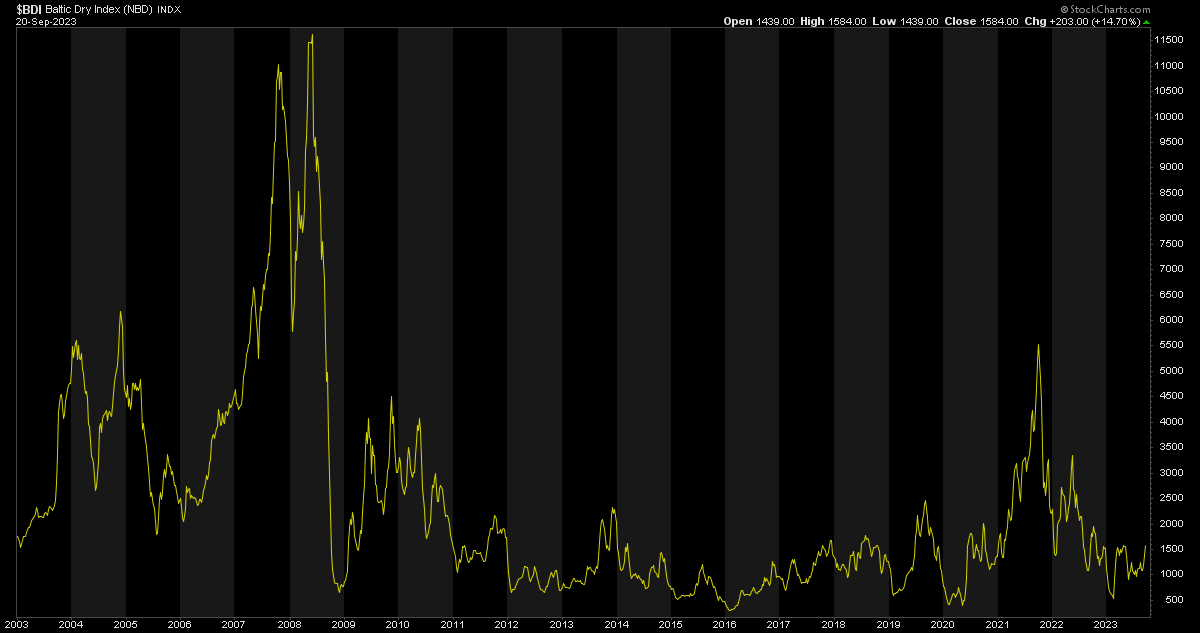September, 21, 2023
And I sincerely believe with you, that banking establishments are more dangerous than standing armies; & that the principle of spending money to be paid by posterity, under the name of funding, is but swindling futurity on a large scale. — Jefferson
The trend is your friend — until it ends.
Credit expands, then contracts. The latter is now the case. As the ongoing credit tightening works its way through the global financial system, we will continuously monitor leading economic indicators as they alter in response. The secular business cycle is turning down and will remain depressed for many years. Reactionary attempts by central bankers to counter the inevitable only make matters worse in the end. This does not mean they won’t try.
Since the 2006 economic peak, a steady credit contraction has been underway, masked by the trillions annually thrown at the problem every year since. What is the problem? The inevitability of a runaway collapse of the global financial system, resulting in wholesale bankruptcies. What triggers a debt contraction? When bankers are afraid to lend and/or borrowers are afraid to borrow. Once this mindset becomes established, it must run its eventual course until all the excesses are wrung out of the system. These excesses include all the entities which were built on a foundation of sand, in the form of fiat money. We have too many colleges, too many factories, too many homes, too many restaurants, too many airplanes, too many bureaucrats, too large a military, too many retailers. And too many economists. These excesses would never have been created had it not been for easy money.

With credit card interest rates now averaging over 20%, this reveals bankers are leery of extending further credit. It also means existing revolving credit lines will be paid off and not renewed, another way credit contracts. 20+% interest is unsustainable for any loan longer than a temporary, emergency one.
What matters is not so much the interest rates on credit card debt (because if the balance is paid off monthly, there is no interest paid), but how many are paying interest monthly. That number is climbing, evidence of deteriorating liquidity. Deteriorating credit card debt is the leading indicator for overall credit contraction. Now that rates and the percent paying them are rising in tandem, these individuals are stressed. This will not end well for these accounts.
$1.02 trillion in credit card debt is now outstanding. Much of this will either soon be paid off or defaulted on. The 2008 crisis yielded a giant step upward, while the pandemic initiated another jump. These caused almost a tripling in the total since 2009. Increasing numbers of consumers are increasingly stressed.
Untapped credit card lines have been rising for a decade, further confirmation of unwillingness on the part of borrowers to increase existing debt, combined with reckless bankers attempting to convice their customers otherwise. Over four times as much of this credit sits unused as is outstanding. You can bring a horse to the bank, but you can’t make him drink the debt.
Rates on auto loans have doubled over the past six years, mostly in the past 18 months. This inevitably leads to decreasing demand. These have reached levels witnessed prior to the 2008 collapse.

We begin with relevant domestic economic data. 3-month Treasury yields are in yellow below, with the Producer Price Index, in white, used as a proxy for inflation because the Consumer Price Index displays different aspects of a complex picture. The red vertical line indicates the Fed’s initiation of credit tightening, after a year of horrific inflation during Biden’s first year.
Note that a few months after tightening was initiated, prices begin to deflate. Treasury rates have returned to the level which precipitated the 2008 crisis (blue arrow), although remaining far below the unsustainable levels of four decades ago. The global economic system is far more fragile today than in 1980. While interest rates are lower, the only reason we are now not in total depression has been the trillions pumped into the domestic economy every year since 2008 in a desperate attempt to keep it afloat. What began as one trillion additional fiat dollars created annually accelerated during Biden’s first year. Now that House Republicans refuse to continue along this reckless path — a hyperinflationary effort — the only way forward is down. After 11 decades of continuous and accelerating fiat money creation, the party is over. Inflation remains considerably above its level when Biden was inaugurated. The deflationary cycle is only beginning.
The 2021 Inflation “Reduction” Act was a rhetorical inversion of reality, as is the rest of Bidenomics — lies dressed up as economic policy, policies engineered to destroy the nation. This is the nothing but the latest doomed communist takeover attempt, orchestrated by Obama, et al. with Biden as the nominal leader.
The CCP sucessfully applied such tactics during the 1960s Cultural Revolution, advocating for destruction of the Four Olds: habits, customs, culture, and ideas. The American people will not stand for this.
How messy the ulitmate resolution of this gambit becomes depends on he tactics the regime is willing to apply. All of which only weaken their position. We reside in an era of continuous unforced errors, made by a regime desparate to retain power. The public ultimately decides such matters. It is impossible to take a people someplace they are unwilling to go.
With the fiscally responsible wing of the Republican party now asserting itself during debt increase negotiations, combined with a Federal Reserve focus on fighting the last battle (hyperinflation) rather than the looming deflation immediately ahead, the months and years before us will be particularly rocky. Why is the Fed slamming on the brakes?
Because the Fed is of, by, and for the bankers.
Not just any bankers, but the Big Boys. And the Big Bankers are worried. They see the writing on the wall. They see the rot in their loan portfolios, particularly in commercial real estate and credit cards. They see the upcoming defaults.
The only upside to this nightmare is that the developing crisis ensures an overwhelming Republican victory in 2024. By then it will be too late to do much other than begin to reverse 11 decades of hyperinflationary policies. Democrats’ free ride is over. All they could offer was free handouts to the world’s huddled masses and their public employee unions. Inflation was their free pass. Once market forces put an end to inflation —in spite desparate efforts to keep the bubble afloat — sliding down that mountain of debt will mark the end of the world’s oldest political party.
Democrats came into power as a result of the deflation of the 1930s. They rode the inflationary horse as far as they could, attracting too many Republicans along the way. Now that economic and political cycles are reversing — a slow-motion process underway since 1980 — Democrats’ fortunes will decline in concert with the overall economy.
Inflation is erected upon a foundation of debt. Debt creation is followed by debt destruction. Once a credit contraction of the ongoing magnitude is initiated by market forces, wholesale debt elimination is not optional. This translates into plummeting prices across long years of reduced economic activity. We are not alone. All democracies eventually self-destruct in a debt orgy. Until the music stops. What happens to all the debt? Much of it is worthless, as its issuers are beginning to understand.
The open question for the months immediately ahead is how the Fed and the political class will respond as the walls close in. A panicked attempt to flood the economy with fresh money (which has been ongoing and accelerating since 2008) will result in more of the same — simultaneous inflation and deflation across various economic sectors.
Take the recent lumber roller coaster for example. First record highs, followed by dropping off the cliff. Lumber demand will continue to evaporate as elevated interest rates bring housing construction to a standstill.
The source of inflation is no mystery. The injection of ever increasing rates of funny money into the economy has led to “normal” rates of inflation around the 2% level. (Under a static monetary regime, the trend of prices is moderate deflation, as economies of scale and related efficiencies kick in.) The accelerated cash injections related to COVID and Bidenomics are the proximate cause of the current mess. In the graph below, note the acceleration of money creation in 2020 and its reversion to the trend of recent decades subsequent to that burst. There are no soft landings, neither from the decades-long inflation, nor the recent acceleration. It’s a long way down from here. Of overriding political significance, inflation is by far the leading concern of voters. No other issue even comes close in recnt polling.
The graph immediately below is denominated in “real” dollars, i.e., normalized to the value of dollars c. 1983. The graph below it displays the true number of actual dollars in circulation, now over $20 trillion. Its price scale on the vertical axis is several multiples of the 1983 levels.
In this young decade we have already witnessed the largest jump, followed by the largest decline, in the rate of dollar manufacturing in the nation’s history. The decline in the number of dollars sloshing around in the economy can be attributed to credit contraction. Market forces are now driving events. The trend is your friend — until it ends.
All aspects (and geographic regions) of a national economy do not simultaneously begin to roll over and turn negative. There are leading and lagging sectors. This is evidenced by the continuing hyperinflation in various sectors, including energy and food. Thanks to your Least Favorite President, energy prices are on a tear upward.
Note the pattern developing as depicted below. The past two Democratic administrations took office immediately after a sharp economic downturn (coincidence?) and then proceeded to drive oil prices higher by reducing production. After a couple of years of high energy costs, the economy contracts, driving fuel prices lower.
Livestock prices are at record highs. This is not a result of corn prices, which have been declining thanks to decent growing conditions. High fuel prices likely account for much of the increase in livestock prices.
Heating oil (diesel) is high and moving higher. Under Biden they have reached a record high and have sustained at higher levels. Once the overall economy accelerates to the downside, energy costs will follow, as they did in the 2008 collapse. However, relative to other sectors energy will remain expensive. It is no mystery while energy prices are climbing — and will continue climbing relative to other sectors, due to the Left’s war on fossil fuels. Califoronia's recent lawsuit against five major oil companies, blaming them for climate change, and Biden's canceling of ANWR oil drilling, are only the past month’s assaults. Destroying the Nord Stream gas pipeline did not help the global energy supply.
As we endure intentional efforts to tear down civilization, systems which required long centuries to build are rapidly being dismantled. “Build Back Better” is actually Tear Down Faster. The good news is the tiny minority intent on destroying civilization is overwhelmed by the rest of us with a vested interest in stability. Their temporary grasp on power is coming to an end. An era of instability requires a Highly Stable Genius to repair the damage.
How bad was the recent bout of domestic hyperinflation? This map of global 2022 rates of inflation offers perspective. Gray nations have no economic data. The greener the shading, the greater the 2022 inflation rate. The world’s largest economy came dangerously close to joining a club of monetary degenerates.
Transitioning from the domestic to the global level, a quick gauge of international trade is the Baltic Dry Index of ocean shipping rates. It fell off a cliff in 2007 and never recovered. Considered in inflation-adjusted terms, it has continued to decline. BDI is now near the low end of its range for this century, 85% below its 2008 peak. The recovery from the 2008 crisis was tepid and tenuous, as the entire world economy suffers an extended hangover from decades of playing follow the leader of U.S. led inflation. The outlook for the global shipping industry is rapidly decaying.
The rest of the world is in worse shape than America. As capital flees other jurisdictions, the dollar has been working higher in response. This serves to buffer our inflation rate, exporting it abroad. This buys us time, but inevitably the deflationary chickens will come home to roost in America. China is a basket case, rapidly slipping into permanent decline. Both economic disintegation and demographic collapse, as its birth rate plummets. The beginning of the 2008 crisis can perhaps be considered the high-water mark for China’s economy. Gold lagged for many years in responding to the declining value of the dollar, until over reacting into 2011. For a supposed inflation hedge, it has gone nowhere in the past three years.
A future analysis will focus on gold (and why it is both a poor inflation hedge, and the worst possible asset to hold during a deflation). Beginning in 2011, and lasting four years, the dollar and gold appropriately diverted in opposite directions. In real terms, adjusted for inflation (actual inflation, not phony baloney values concocted by the government), gold has been a turkey since the culmination of its parabolic rise into 2011.



















